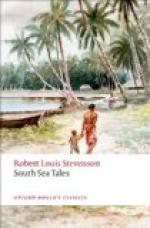Danger is but a small consideration. But men are more nicely sensible of a discomfort; and the atoll is a discomfortable home. There are some, and these probably ancient, where a deep soil has formed and the most valuable fruit-trees prosper. I have walked in one, with equal admiration and surprise, through a forest of huge breadfruits, eating bananas and stumbling among taro as I went. This was in the atoll of Namorik in the Marshall group, and stands alone in my experience. To give the opposite extreme, which is yet far more near the average, I will describe the soil and productions of Fakarava. The surface of that narrow strip is for the more part of broken coral lime-stone, like volcanic clinkers, and excruciating to the naked foot; in some atolls, I believe, not in Fakarava, it gives a fine metallic ring when struck. Here and there you come upon a bank of sand, exceeding fine and white, and these parts are the least productive. The plants (such as they are) spring from and love the broken coral, whence they grow with that wonderful verdancy that makes the beauty of the atoll from the sea. The coco-palm in particular luxuriates in that stern solum, striking down his roots to the brackish, percolated water, and bearing his green head in the wind with every evidence of health and pleasure. And yet even the coco-palm must be helped in infancy with some extraneous nutriment, and through much of the low archipelago there is planted with each nut a piece of ship’s biscuit and a rusty nail. The pandanus comes next in importance, being also a food tree; and he, too, does bravely. A green bush called miki runs everywhere; occasionally a purao is seen; and there are several useless weeds. According to M. Cuzent, the whole number of plants on an atoll such as Fakarava will scarce exceed, even if it reaches to, one score. Not a blade of grass appears; not a grain of humus, save when a sack or two has been imported to make the semblance of a garden; such gardens as bloom in cities on the window-sill. Insect life is sometimes dense; a cloud o’ mosquitoes, and, what is far worse, a plague of flies blackening our food, has sometimes driven us from a meal on Apemama; and even in Fakarava the mosquitoes were a pest. The land crab may be seen scuttling to his hole,




